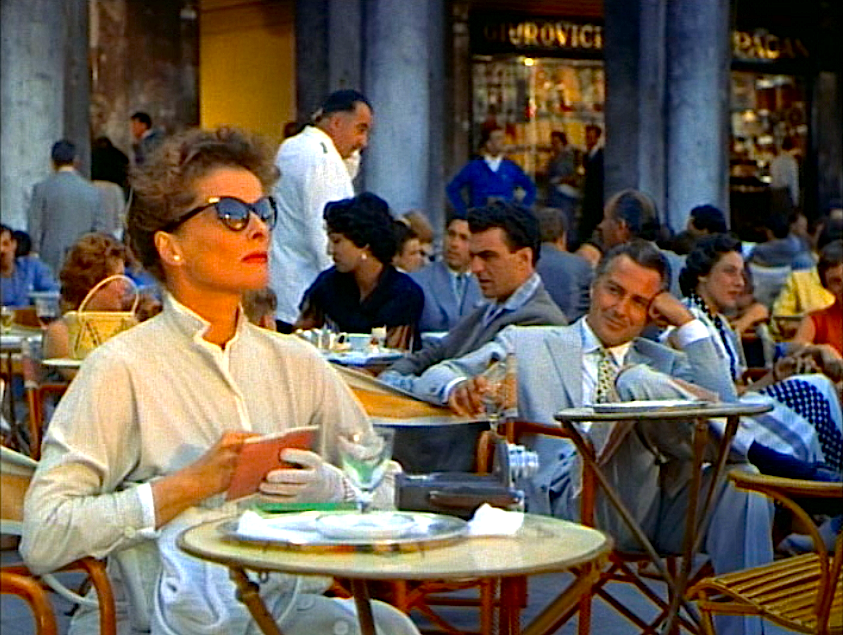MARIANI’SVirtual
Gourmet
August
7, 2011
NEWSLETTER
on the Piazza San Marco,Venice, in "Summertime" (1955)
THIS WEEK
NEW YORK
CORNER:
HOSPODA
by
Mort
Hochstein
NOTES FROM THE SPIRITS LOCKER
To Sell
Vodka, Sell the Sizzle
by John
Mariani
❖❖❖
MARIANI'S QUICK BYTES
If you would like to be featured in our Quick Bytes section please visit our advertisement page at www.JohnMarianiMedia.com
*Paid Advertisements*
|
The Miami International Wine Fair
The Miami International Wine Fair (MIWF) celebrates its 10th
anniversary as the leading wine trade expo in the country, September 23
- 25, 2011 at Hall A of the Miami Beach Convention Center. Now an
industry only event, organizers anticipate more than 1,500 wines and
500 producers exhibiting across 65,000-sq-ft. Transforming the
hall into virtual wine country, MIWF will debut The Florida Room - a
10,000-sq-ft pavilion of regional producers, creating a one-stop shop
for Florida-based buyers. Also uncorking the Fair is the Florida
International Wine Challenge (FIWC), which will for the first time take
place contemporaneously with the main event. For more information,
please call 866.887.WINE or visit www.miamiwinefair.com . |
|
City Harvest
City Harvest, the world's
first food rescue organization which feeds over 300,000 hungry New
Yorkers each week, is announcing a brand new event: The Brooklyn Local.
On Saturday, September 17th, over 75 artisinal vendors will converge at
Brooklyn Park to showcase the best of Brooklyn food and to help City
Harvest feed more hungry New Yorkers. For more details visit www.CityHarvest.com |
|
Australian Perigord Truffles
AUSTRALIAN PERIGORD
TRUFFLES, The Trufferie in Manijump is unearthing some of the most
potent Perigord aroma that eclipses most of what is found in the
European winter. The Chefs Diamond Company www.thechefsdiomand.com
suppliers to this Countries most renowned Chefs, has just recently
started selling Fresh Truffles to the retail market, Private Chefs and
Foodies please visit our online store for what's sure to leave you
captivated... These Perigord Truffles are not to be misinterpreted, Yes
they are available fresh and YES they are The True Perigord Spore...
For more info visit the Farm Down Under www.wineandtruffle.com.
Chefs please call King Truff at 219-798-5662 or email
kingtruff@gmail.com |
❖❖❖
by John Mariani
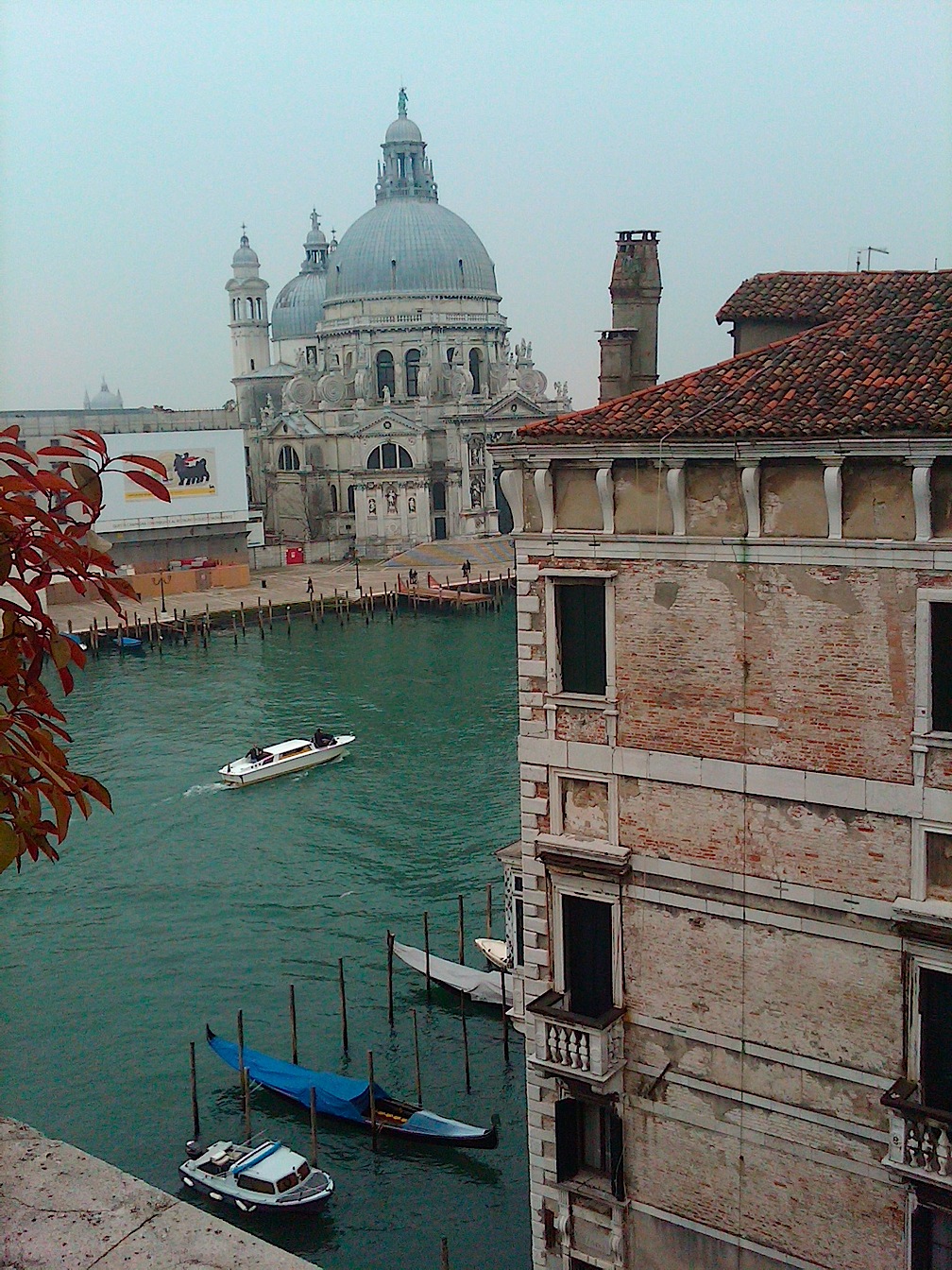 For
much
of
its
history
Venice was the mighty ruler of the Eastern
Mediterranean, yet it was lovingly called La Serenissima. It dominated
the sealanes' shipping, controlled most of the spice trade, and
never
went to war if an alliance could be worked out instead. Its
Renaissance artists--Titian, Tintoretto, Veronese--were the masters of
their era, and its glassware was known around the world.
For
much
of
its
history
Venice was the mighty ruler of the Eastern
Mediterranean, yet it was lovingly called La Serenissima. It dominated
the sealanes' shipping, controlled most of the spice trade, and
never
went to war if an alliance could be worked out instead. Its
Renaissance artists--Titian, Tintoretto, Veronese--were the masters of
their era, and its glassware was known around the world.But by the 18th century Venice's greatest days were behind it. Invasions and plunderings by the Austrians, then Napoleon, the end of the Republic, and two World Wars robbed Venice of its grandeur and power, yet the city's spirit, at its height during Carnevale, has never flagged and the city's beauty, despite the ravages of the waters that surround it, has always drawn the world to its bosom, first by the thousands, then by the millions. "Sempre crolla ma non cade" is a Venetian proverb that means, the city is always collapsing but never fallen, for the city survives every assessment of its imminent demise as the waters of the Adriatic flow in and out of its lagoons, lapping over into the streets and up to the windows, regularly flooding the Piazza San Marco.
To Byron the city was a reverie and revelry--"the greenest island of my imagination"; Henry James thought it a "vast museum"; Shelley called its "Earth's nursling," and Truman Capote said the city was like "eating an entire box of chocolate liqueurs in one go."
Wax and wane as it does, Venice is not what it once was: tourism has appropriated the city entirely, so that the 60 thousand people who are still residents of the city--one -third the number of a century ago--may in fact all be gone in thirty years, leaving its wonders, its hotels, restaurants, and boutiques selling carnival masks all to the tourists, thousands of whom increasingly disgorge from huge oceanliners every day onto San Marco. Peter Ackroyd explains in his splendid new city profile, Venice: Pure City, why the city seems so empty at night: "It is empty. It is hard to imagine a time when it was a city full of local people. Of course, in the day, it is full of tourists. But paradoxically tourists empty a place by their presence. They turn it into a spectacle without depth." He goes on to say that the city of tourist is now the real Venice, its algae-stained stones and art in need of restoration testament to a past that has little native claim on the present.
Still, it is the most magical city on earth, an operatic city, and a city of high hospitality and fine food.
It is also very very expensive, especially during a season that lasts from late April through October, when the crush of crowds can literally be dangerous and when restaurants hike their prices for the tourists while secretly charging the locals less. There is, as far as I can see, no defense against this policy except to move to Venice and over years become a Venetian, and learn the local dialect for words like vaporetto (batèo), shoemaker (biavaròl), and fog (caìgo).
Yet for all that, Venice is wholly irresistible, and its luxuries and cuisine among the finest in Italy. On our last visit in April, t
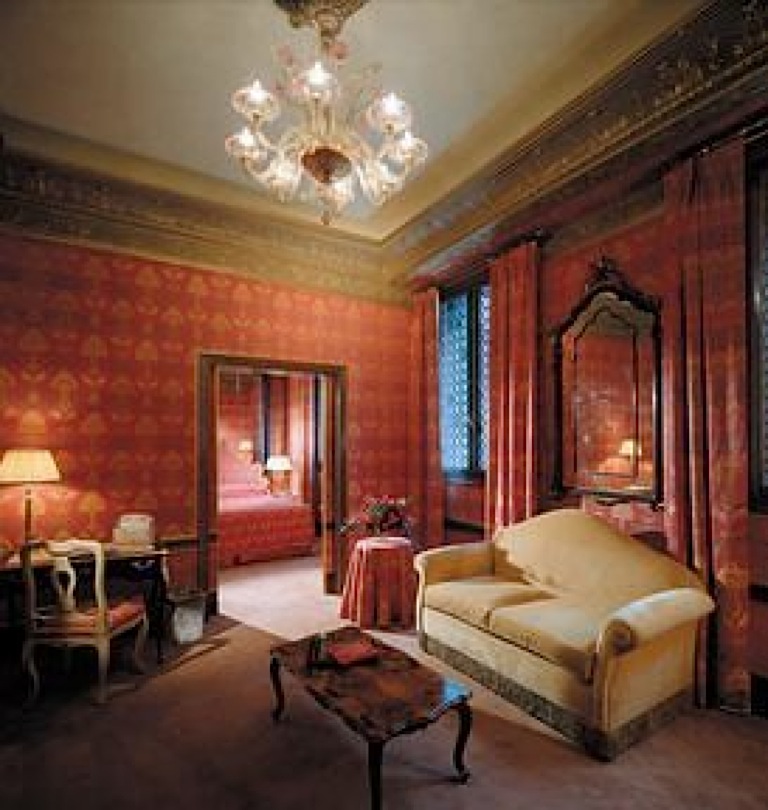 he
city
was
only
slightly less crowded than in
season--it was the weekend of Valentine's Day!--so we were happy to
collapse into the glory of Il Palazzo, an 18th
century wing appended to the 1940s main building of the Bauer Hotel, a
two-minute walk from San Marco.
This truly is a true Venetian palace, with its view of the Grand Canal
(the photo above is from our room's balcony), with
44 deluxe rooms and 38 suites, many with walk-in closets
and fireplaces, exquisite fabrics and silks and Murano glass
throughout. There is a gym here with sauna, steam room
and Jacuzzi on the roof
top terrace.
he
city
was
only
slightly less crowded than in
season--it was the weekend of Valentine's Day!--so we were happy to
collapse into the glory of Il Palazzo, an 18th
century wing appended to the 1940s main building of the Bauer Hotel, a
two-minute walk from San Marco.
This truly is a true Venetian palace, with its view of the Grand Canal
(the photo above is from our room's balcony), with
44 deluxe rooms and 38 suites, many with walk-in closets
and fireplaces, exquisite fabrics and silks and Murano glass
throughout. There is a gym here with sauna, steam room
and Jacuzzi on the roof
top terrace. The hotel is owned and run impeccably by the lovely Francesca Bortolotto Possati, whose taste is evident in every corner, richly upholstered or lacquered, gilded, with chinoiserie, and tapestries by Bevilacqua and Rubelli. There are two entrances here, a private jetty on the Grand Canal and a doorway in the Calletta dei XIII Martiri.
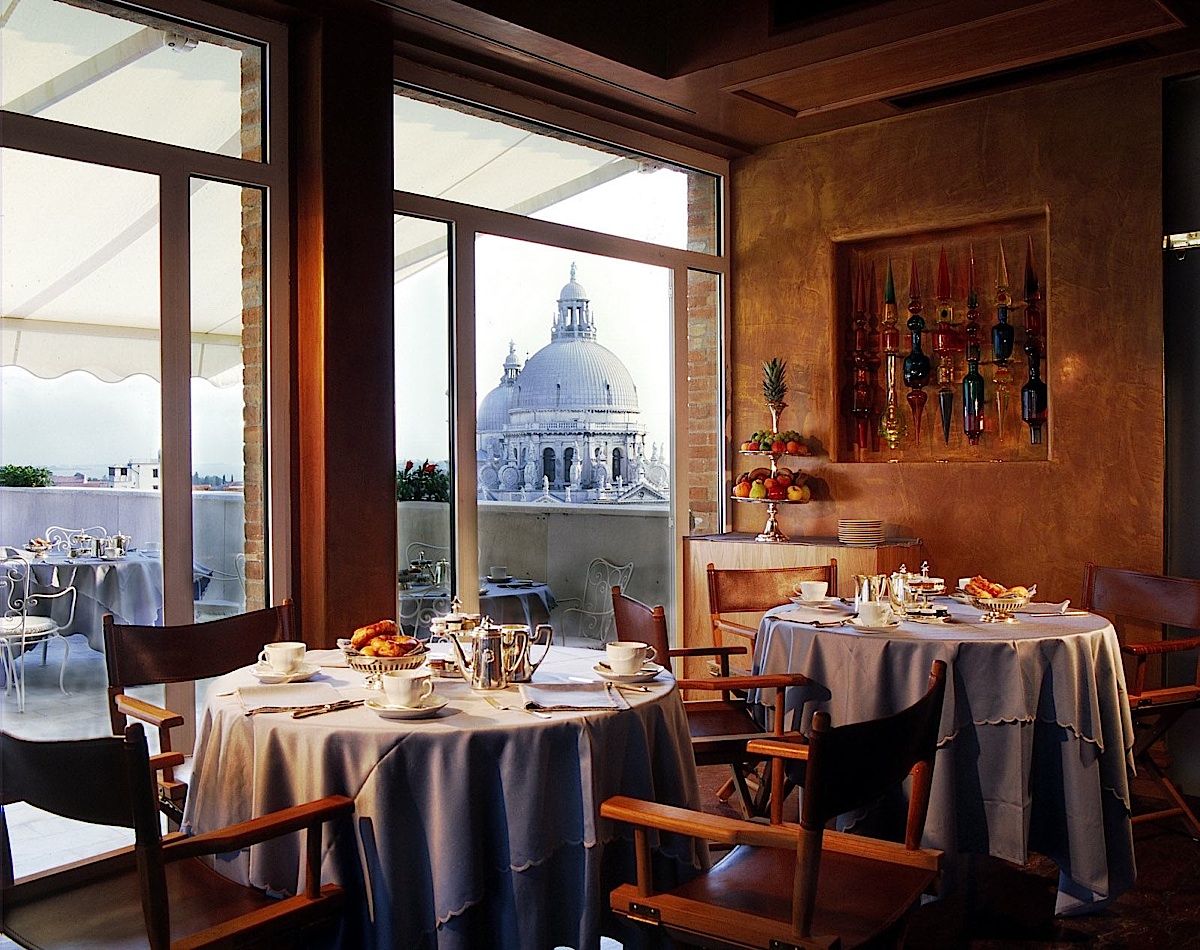 Push through
the shining revolving doors and you enter a long, wide lobby set with
very comfortable chairs (most hotels discourage lounging in the lobby
for
fear of non-guests coming in), and the reception at the desk, by a
series of handsome front desk concierges, led
by Paolo di Vacri, makes everyone
feel that Senora Possati has herself written a personal note on your
behalf. Ask them to arrange for anything in town--reservations,
tickets, a banquet on the rooftop, a speedboat to the
airport--which is docked right at the
hotel's jetty--and consider it done within moments. You'll be
escorted
to your room, and the chances are you will run into general manager
Pietro Rusconi throughout your stay, asking you not if everything is
all right but
what possibly can he do to make your stay even more comfortable.
Push through
the shining revolving doors and you enter a long, wide lobby set with
very comfortable chairs (most hotels discourage lounging in the lobby
for
fear of non-guests coming in), and the reception at the desk, by a
series of handsome front desk concierges, led
by Paolo di Vacri, makes everyone
feel that Senora Possati has herself written a personal note on your
behalf. Ask them to arrange for anything in town--reservations,
tickets, a banquet on the rooftop, a speedboat to the
airport--which is docked right at the
hotel's jetty--and consider it done within moments. You'll be
escorted
to your room, and the chances are you will run into general manager
Pietro Rusconi throughout your stay, asking you not if everything is
all right but
what possibly can he do to make your stay even more comfortable.The Palazzo’s bar has become a very sophisticated spot for meeting before dinner at the hotel’s restaurant, De Pisis (left), with its fantastic view over the Grand Canal, and an outdoor patio whose tables are much favored. Once, while dining there with my family, our meal was suddenly interrupted by a fearsome thunderstorm. With uncanny grace under pressure, the white jacketed staff collected linens, china, and glassware and had everyone seated and served within minutes, as the storm blew quickly out to sea--all handled with the nonchalance of changing of a skipping record, so that what might have been a disaster became a fond family memory.
I did not have a chance to dine at De Pisis this time, but those interested in the very modern
 Venetian cuisine should check out the menu by
clicking here.
Venetian cuisine should check out the menu by
clicking here.Senora Possati has also recently opened on the island of Giudecca a new boutique property called Villa F, once a luxurious pensione for artists, actors and writers, located in a Renaissance palazzo, now converted for all modern amenities.
We did pay the obligatory visits--two actually--to Harry's Bar and enjoyed the experience immensely, but I shall be writing about that in an upcoming issue of the Virtual Gourmet.
We also visited an old favorite of mine--a place whose
location just to
the left of the Rialto Bridge, down a broad, dark alley, suggests
it should be
as overwhelmed by tourists as all the ristoranti
lining the Canal with their waiters exhorting you to sit and have the menu turisici.
But at Alla Madonna (right), here since 1954, the
majority of visitors seem to be Venetians, or
at least Italians; I have noticed more than a few Asian tourists
seem to get the tables in one of the smaller, unattractive rooms in
this large
trattoria.
Alla Madonna is fast paced, but you may linger over
a bottle of cold soave as long as you like, if not only to eat at your
own
pace but simply to watch the interplay of Italian hand gestures
throughout the
room. The waiters never seem to change here, and the place is
wonderfully bright, decked out with memorabilia and Venetian artwork.
It is a very jolly place, and the simple traditional food is first
quality, not least the fish, which is bought from the market just
meters away.
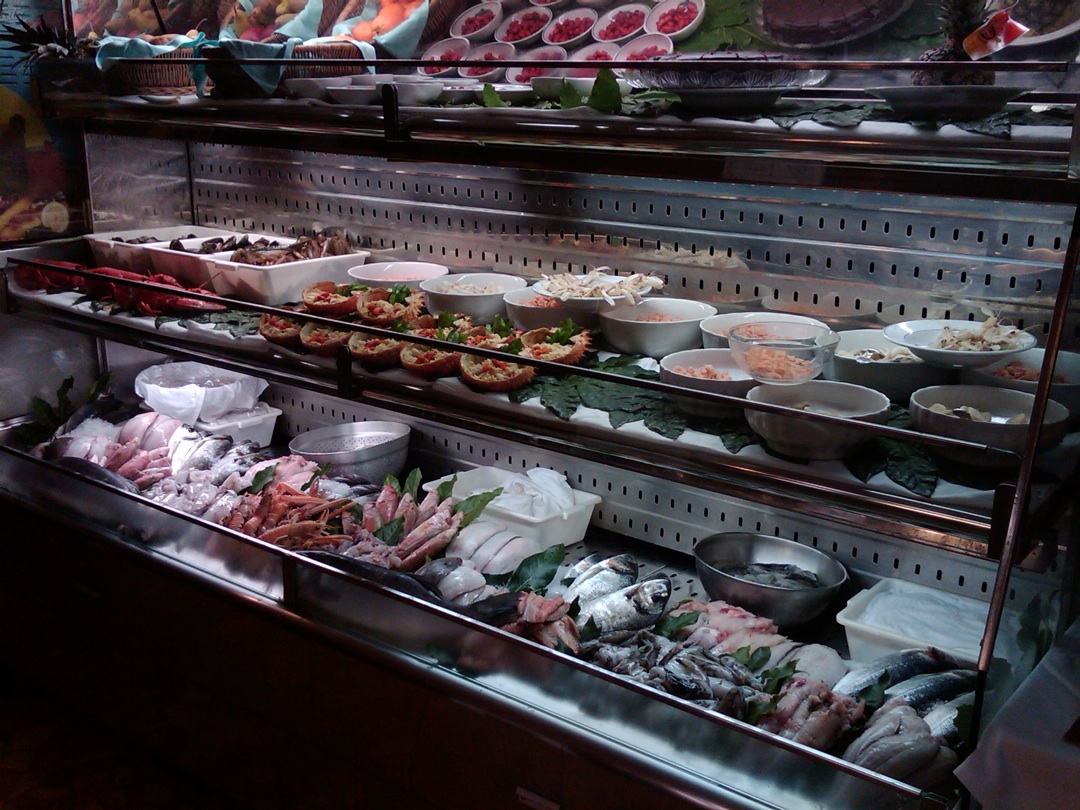 There are certain dishes here you
may well find all over town, but at Alla Madonna they take real care,
so stay classic Venetian: Start with an antipasto of misto di pesce of
local seafood--canoce, gamberetti,
polpetti--then have the risotto
ai
frutti
di
mare or the vermicelli with squid ink. For a main
course,
the crab (granseola) is
wonderful if in season, and the fritto
misto
is a paragon of expertly fried seafood. Go simple with any number of
the arrayed fish
species (left) perfectly
grilled, but if you have a hankering for meat, by all
means have the Venetian specialty fegato
alla
veneziana, tender, calf's
liver with a shower of sweet caramelized onions. You may easily
skip dessert. A meal for two here is a bargain compared to most
places in the city. Figure about 30 euros per person.
There are certain dishes here you
may well find all over town, but at Alla Madonna they take real care,
so stay classic Venetian: Start with an antipasto of misto di pesce of
local seafood--canoce, gamberetti,
polpetti--then have the risotto
ai
frutti
di
mare or the vermicelli with squid ink. For a main
course,
the crab (granseola) is
wonderful if in season, and the fritto
misto
is a paragon of expertly fried seafood. Go simple with any number of
the arrayed fish
species (left) perfectly
grilled, but if you have a hankering for meat, by all
means have the Venetian specialty fegato
alla
veneziana, tender, calf's
liver with a shower of sweet caramelized onions. You may easily
skip dessert. A meal for two here is a bargain compared to most
places in the city. Figure about 30 euros per person.
There
are
two
pre-eminent
seafood
ristoranti in
Venice, both frequented by American tourists because they really are so
superior and much reported on by the travel media. One is Corte Sconta,
not easy to find in the back streets of Castello; here you just
sit down, preferably al fresco, and they will begin
bringing you platters of seafood until you holler
"basta!" and you pay the bill,
which will not be not cheap, but that depends on if you
stop after the fried seafood, the steamed seafood, the grilled
seafood, or the dessert.
The
other
Castello
restaurant I love is Al Covo, again down
a few alleys, ten minutes' walk from San Marco, on the way to the
Arsenale. It was
opened in 1987 by Cesare Benelli, whose mother
was Tuscan, and his wife Diane, who was born in Texas (which makes this
quite appealing to Americans not up on their Venetian dialect). It's a
nice touch that their website notes ithe place is "semi formal," though
certainly not in the sense of effusive elegance; it's just a
very pleasant and comfortable two-room restaurant, quiet and well run.
Still, at dinner gentlemen are "sconsigliamo
pantaloncini
corti,
cannottiere
e
sandali"--"discouraged from wearing shorts,
t-shirts and
sandals" and while "I bambini
sono ben accetti ma devono
adeguarsi al nostro menu che non prevede piatti specialmente
disegnati per loro"--"children are welcome, but Al Covo's menu
is not
really designed for them."
The menu at Al Covo is clearly based on which
species was brought in from the market that day. The carts in the
dining room display what those would be, or Cesare will bring out a box
of an unusual catch that might be available for only a week that
season, like the tiny shrimp the Venetians call schile. There might be cocciole (cockles) or San Pietro,
or any number of crabs. You might begin with culatello ham slices with with
sweet figs, or fresh, marinated anchovies with eggplant. For 18-24
euros you may have a selection of antipasti,
and
by
all
means choose the Venetian specialties "in
saor," a sweet and sour marinade
with fish and vegetables, so simple, so pure, so delicious.
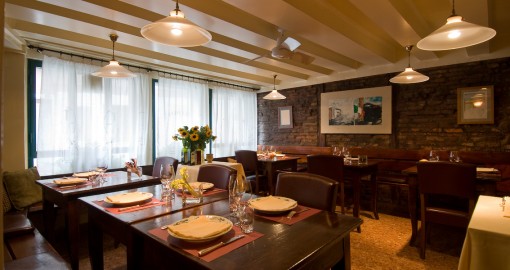 For
a
pasta,
consider
the risi e bisi--rice
and
peas--or
rigatoni with a pistachio pesto and bottarga
roe.
For
a
pasta,
consider
the risi e bisi--rice
and
peas--or
rigatoni with a pistachio pesto and bottarga
roe. The main courses include several meat dishes, beef, veal chop, rack of lamb, but it is always difficult to resist the wonderful seafood here, like the monkfish with a fonduta of potatoes and artichokes, or the swordfish from Taranto with eggplant, tomato, basil and an olive paste.
Al Covo has a first-rate wine list, not to badly priced, with plenty of wines from Veneto on it.
I've never heard anyone do anything but praise the warm welcome from the Benellis, both of them demonstrating a genuinely palpable love of pleasing people with their cooking and their willingness to educate. I'm sure Diane has told the story a thousand time of how she met Cesare and moved to Venice, so when you go, she'll be happy to tell you too.
by Mort Hochstein
HOSPODA
321 East 73rd Street (near
First Avenue)
212-861-1038.
www.hospodanyc.com
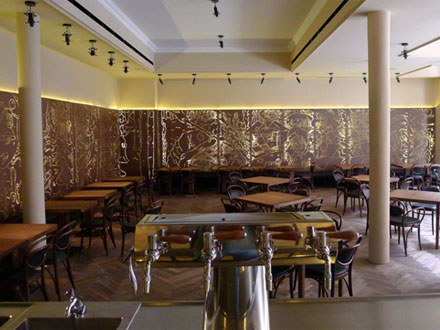 When
my
wife
and
I
were
much
younger,
we
ate often
at Sokol Hall, far
over east on 71st
street
between First Avenue and York. It was then
a
part of the ethnic
Czech New York community that flourished in Yorkville, a neighborhood
that in the 19th century drew German, Czech, Hungarian, and Polish
immigrants by the thousands, some of whom opened restaurants.
Sokol Hall specialized in duck, and
I’ve never found another restaurant in
NYC
that
made
it
as
well--with
the
possible
exception of Lüchow’s on 14th Street,
now also only a memory.
When
my
wife
and
I
were
much
younger,
we
ate often
at Sokol Hall, far
over east on 71st
street
between First Avenue and York. It was then
a
part of the ethnic
Czech New York community that flourished in Yorkville, a neighborhood
that in the 19th century drew German, Czech, Hungarian, and Polish
immigrants by the thousands, some of whom opened restaurants.
Sokol Hall specialized in duck, and
I’ve never found another restaurant in
NYC
that
made
it
as
well--with
the
possible
exception of Lüchow’s on 14th Street,
now also only a memory.
The restaurant disappeared
sometime in the seventies,
along with many of its Czech congregants, who seem to have relocated
across the
East River in Queens. Today the center of Czech cultural and social
history in
New York is the restored Bohemian National Hall, two blocks north,
almost
parallel, on
East 73rd street. While
attending an event at the hall two years ago, I learned that a new
Czech
restaurant, based on one in Prague, was soon to open in the building.
Memories
of the old Sokol Hall were stirred up and I waited in great
anticipation until
this spring, when the long-awaited restaurant and beer pub, Hospoda,
finally
opened in that landmark building, now owned by the Czech Republic.
Hospoda (Czech
for beer hall) is part of a group
that owns 14 restaurants in Prague. The
NYC shop is beer oriented, and
its simple, bare walnut tables and extremely modern décor are
hardly related to
the dark woods and heavy
furnishings that had characterized the old Sokol Hall. It is, I
suppose, what
we
now call a
gastropub, but the décor reminds me of a Mitteleuropean coffee 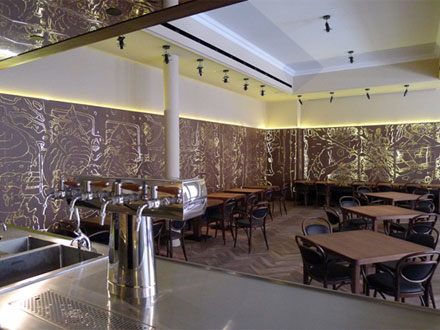 shop
where
patrons
might
linger
all
day
reading
journals
and
discoursing on world
affairs. It is sparsely decorated, once
you
get
past the engraved abstract scenes carved on the wall by the Czech
street
artist
known only as Masker.
shop
where
patrons
might
linger
all
day
reading
journals
and
discoursing on world
affairs. It is sparsely decorated, once
you
get
past the engraved abstract scenes carved on the wall by the Czech
street
artist
known only as Masker.
Indeed, patrons do linger,
but
here they linger over
beer served in drafts from a unique bar, made almost entirely of glass (right),
allowing guests to see its operating mechanisms and beer reserves. The
transparency theme continues underfoot where a long stretch of glass
flooring
allows you to look down at beer
kegs in the basement below. Standing over that large pane and peering
down into the cellar gave
me
the
uncomfortable
feeling
of
riding
on a
glass-bottomed tour boat. I quickly sought security on the wooden floor.
Lukas Svoboda, who triumphed over
several thousand rivals
last year to
win the title of 2010 International Pilsner Urquell Master Bartender, readily explains to patrons the four
distinct, technical pours he offers. They are Crem Urquell, the
classic
style,
balanced
with
creamy
head;
Slice,
with a more
substantial
head,
slightly bitter; Sweet,
a slightly softer variation that
appears to be entirely head ; and 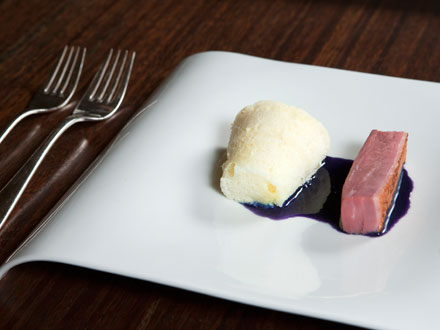 Neat, with no head and unique sharp and
bitter flavor. The beer arrives by boat across
the
ocean
from
the
historic
Pilsner
Urquell
brewery
in Pilzen (CQ),
Bohemia.
Neat, with no head and unique sharp and
bitter flavor. The beer arrives by boat across
the
ocean
from
the
historic
Pilsner
Urquell
brewery
in Pilzen (CQ),
Bohemia.
But what
about the duck, which was one of my main
reasons for visiting Hospoda? No complaints, and though Chef Oldrich
Sahajak and Marek Sada, who come from Prague's highly regarded La
Degustation Bohême Bourgeoise, take
a more modern approach, I was happily reminded of the good old days at
Sokol
Hall. He served three slices of medium-rare duck breast, accompanied by
an imported
plum jelly, a dollop of sour cream and thyme shortbread.
The duck came from the chef’s portion
of the menu, which also listed several Czech dishes.
My partner elected Prague-style ham, dressed with
horseradish foam—a modern touch the folks in the old country
might find
challenging--- and pickled vegetable.
There were all sorts of other enticing dishes on
the
list,
including slow baked lamb leg with eggplant puree,
roasted pork belly with red cabbage essence, dumpling and
Savoy cabbage,
and the one that is going to bring me back, smoked beef tongue with a yellow pea puree and pickled spring
onion.
The wine list has global reach, including many
bottlings from Germany and Austria, but there are no Czech or Slovakian
wines available.
What Hospoda serves up is
not exactly what I might have encountered those many years ago in
Yorkville, but the
restaurant is certainly a worthwhile addition to the casual dining
scene in
Manhattan, and it revives an ethnic flavor long missing on the scene.
Dinner, Mon.-Sat. Lunch will begin in the fall; Fixed price dinners two plates for $32, $45 for three.

MAN ABOUT TOWN
by
Christopher Mariani
Kenmare Gets a New Chef
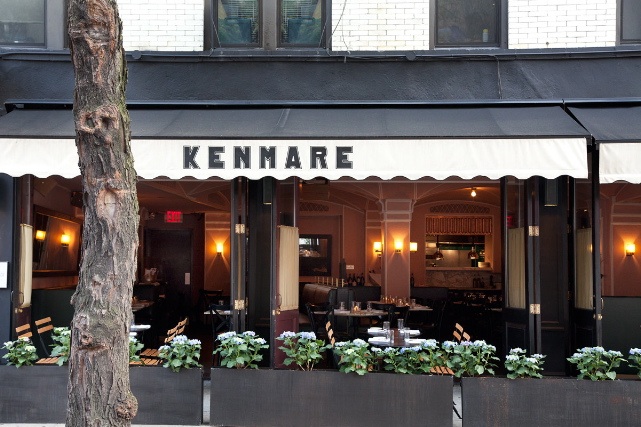 My plan was to ride the train into Manhattan,
stop by Eataly for some shopping and then meet my brother and his
gorgeous
girlfriend for dinner at Kenmare (98 Kenmare Street; 212-274-9898).
Upon exiting Grand Central I was greeted with
a blast of summer rain that almost soaked my entire outfit. With
a bit of luck I
caught a cab immediately and headed straight for Kenmare, north of Little Italy—the section dubbed NoLita—so
my visit to Eataly was out of the question. There was no way I would be
lucky
twice on such a rainy day.
My plan was to ride the train into Manhattan,
stop by Eataly for some shopping and then meet my brother and his
gorgeous
girlfriend for dinner at Kenmare (98 Kenmare Street; 212-274-9898).
Upon exiting Grand Central I was greeted with
a blast of summer rain that almost soaked my entire outfit. With
a bit of luck I
caught a cab immediately and headed straight for Kenmare, north of Little Italy—the section dubbed NoLita—so
my visit to Eataly was out of the question. There was no way I would be
lucky
twice on such a rainy day.
I
arrived
at
Kenmare
around
6:20 pm, early by NYC standards for dining, and was
not surprised that I was the only guest in the restaurant. My
reservation was
not until seven pm, so I took a seat at the bar and ordered a tall
negroni. It
was obvious the bartender had a good amount of set-up to take care of
prior to
service yet he found time to chat with me and keep me company for
almost 40
minutes, a very nice touch and a much appreciated gesture. Oh, and the negroni was excellent.
When
my
party
arrived,
I
said farewell to the bartender and was led to my table
by a
beautiful, tall blonde hostess who wished us a wonderful evening after
seating us
at a very comfortable banquette. The room seats around 100 people, with
white
marble table tops, candles on 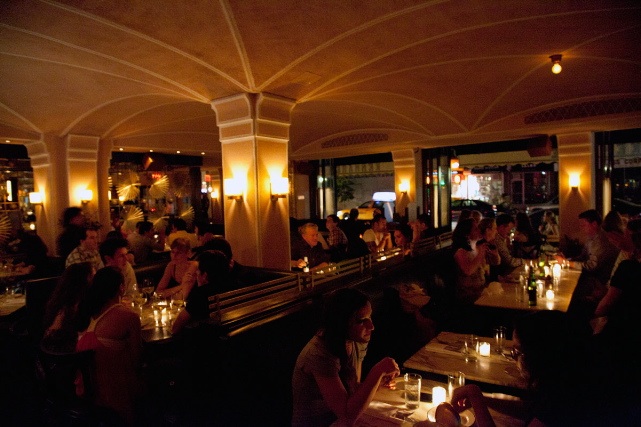 every
table, an amber hue throughout the
entire
restaurant, and a very lively bar after nine pm. The music goes on
throughout
the night, but at that early hour it was a
bit loud, considering we were the only table in
the dining room
and the speaker hung directly above our heads.
every
table, an amber hue throughout the
entire
restaurant, and a very lively bar after nine pm. The music goes on
throughout
the night, but at that early hour it was a
bit loud, considering we were the only table in
the dining room
and the speaker hung directly above our heads.
After
ordering
a
bottle
of
Soffacone di Vincigliato (the original label is very
controversial) from Kenmare’s limited yet
modestly priced wine list, we started with a selection of appetizers by
the new
executive chef, Gilbert Delgato. The top two starters included a
heirloom
tomato salad layered with shreds of fresh burrata cheese,
drizzled with
a fine olive oil and balsamic vinegar, along with gravy meatball
sliders made
with beef, pork, veal and pecorino,
a staple on Kenmare’s 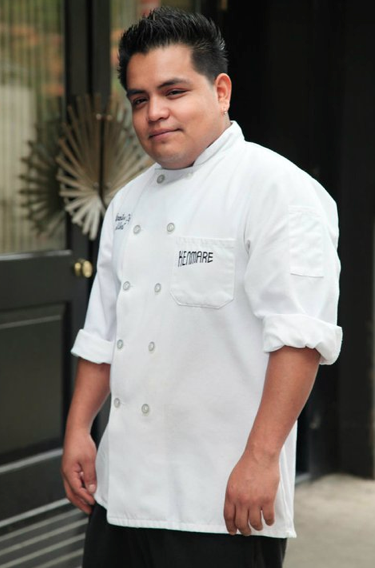 menu
since opening just a little over one year
ago. The grilled
octopus was a little chewy and although one-dimensional, still tasty.
There was
absolutely nothing wrong with the crab cakes, but they were not of the
style
found at some of the great NYC steakhouses, that is, they were not
filled with big
hunks of lump crabmeat.
menu
since opening just a little over one year
ago. The grilled
octopus was a little chewy and although one-dimensional, still tasty.
There was
absolutely nothing wrong with the crab cakes, but they were not of the
style
found at some of the great NYC steakhouses, that is, they were not
filled with big
hunks of lump crabmeat.
For
our
main
course,
crispy,
pounded veal Milanese came stuffed with provolone
and topped
with a lightly dressed arugula salad. Having just returned from
Piedmont, I can declare that Kenmare’s veal Milanese is a great
example, slightly heavier than what is
typically found in Northern Italy but still wonderful. Kenmare’s other
standard
dish is “The Chicken,” succulent,
seasoned lightly and sided by a summer potato salad mixed with green
string
beans and onion. Delgato’s burger, made with ground ribeye, would
please any NYC
burger aficionado and comes with a side of addictive cheddar French
fries.
Sides included the best onion rings I’ve ever tasted, cooked in a
tempura style,
and a bowl of overly salted sautéed spinach.
Desserts
could
use
some
improvement,
as the flan was soupy and the bombolini
too doughy.
Chef
Gilbert
Delgato
is
doing
a good job for a restaurant that opened as one of
Manhattan’s hottest restaurants just last year, serving simple dishes
he knows
how to cook well. There is always room for refinement, but
overall you will
not be disappointed with a meal at Kenmare.
NOTES
FROM
THE
SPIRITS
LOCKER
by John Mariani
 How is it that a
spirit defined by the U.S. Standards of Identity as “without
distinctive character, aroma, taste, or color” became one of the
world’s
largest sellers? In fact, after a Russian émigré bought
the rights to make
Smirnoff vodka in the U.S. in the 1930s, it was advertised as a “White Whisky
— No taste. No smell." Which meant no telltale booze
breath.
How is it that a
spirit defined by the U.S. Standards of Identity as “without
distinctive character, aroma, taste, or color” became one of the
world’s
largest sellers? In fact, after a Russian émigré bought
the rights to make
Smirnoff vodka in the U.S. in the 1930s, it was advertised as a “White Whisky
— No taste. No smell." Which meant no telltale booze
breath.
Back
in
1987,
when
Poland
was
still
a Soviet state, I visited the Wyborowa
distillery outside Warsaw, where I was challenged to taste the
differences
between vodka made from potatoes or rye, the latter the basis of
Wyborowa’s
distillate and its big selling point. After sniffing and sipping and
finding
virtually no difference, I simply guessed which was which. One of the
Wyborowa
executives laughed and said I’d guessed wrong, saying this one was
Wyborowa and
that one a Russian potato vodka. At which
point the plant’s master distiller sheepishly said, “Actually,
sir, that one is the Wyborowa and this one the potato.”
Vodka may be
distilled from any starch/sugar-rich
plant
matter,
including sorghum,
sugar
beets,
corn,
rye
or wheat,
even
grapes,
though
this
last
is controversial among the EU nations f or being too
far from the
original idea. The result of distillation is almost pure alcohol, which
is then
cut with water to achieve a standard 40 percent alcohol level in the
bottle—although
some devastating rarities can hit 95 percent. Rarely is vodka aged.
or being too
far from the
original idea. The result of distillation is almost pure alcohol, which
is then
cut with water to achieve a standard 40 percent alcohol level in the
bottle—although
some devastating rarities can hit 95 percent. Rarely is vodka aged.
The
fact
is,
vodka
has
traditionally
been
sold by ad campaigns, not flavor, the
most famous of which have been Sweden’s Absolut ads in which they
always
cunningly place their distinctive bottle shape into themes, like
Absolut
Psycho, with a shower curtain torn into the shape of their bottle.
Stolichnaya
has always made much of its true Russian heritage, while Holland’s
Ketel One’s
recent TV ad refers to a time “when men were men” and “didn’t drink
their vodka
from delicately painted perfume bottles.”
Other
brands
insist
their
vodkas
are
all
the more pure for being made with
million-year-old water poured through diamonds and quintuple distilled.
Still,
it’s hard to increase sales of a neutral, tasteless, odorless spirit on
ads
alone, which is why the industry has come up with so many flavored
vodkas, like Kubanskaya with dried lemon and
orange peels; Ciroc, with coconut and red berry; Pertsovka, with black
pepper
and chilies; and Okhotnichya, with ginger,
cloves, lemon peel, coffee, anise, sugar and white port.
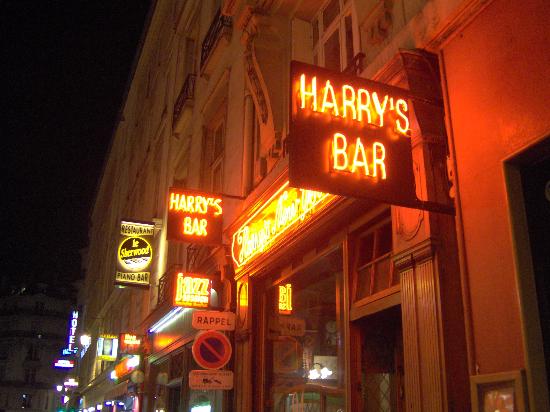 Flavored
vodkas are nothing really new. I have enjoyed many a Russian Easter
meal after
midnight mass, accompanied by vodka flavored by my host with lemon,
pepper, or
buffalo grass.
Flavored
vodkas are nothing really new. I have enjoyed many a Russian Easter
meal after
midnight mass, accompanied by vodka flavored by my host with lemon,
pepper, or
buffalo grass.
Vodka
is
also
the
basis
for
the
Bloody Mary, created at Harry’s New York Bar in
Paris
during Prohibition, and James Bond’s enormously influential 1950s vodka
martini he called the Vesper (right), along
with the screwdriver, the cosmopolitan made famous by the women
of “Sex & the City,” and, thanks to the 1998 movie “The Big
Lebowksi,” the
white Russian.
Thus,
given
how
unflavored
vodkas
add
little
or no flavor of their own  to cocktails
made with orange juice or Kahlúa, it’s baffling to me when vodka
aficionados
order an expensive for such concoctions.
to cocktails
made with orange juice or Kahlúa, it’s baffling to me when vodka
aficionados
order an expensive for such concoctions.
So
I
decided
to
do
a
blind
tasting of a dozen unflavored vodkas, most fairly
new
in the market, some oldtimers, to see what differences I could detect.
They
were not, shall we say, pronounced. I doubt many people who swear by
their
favorite brand could ever pick it out in such an array.
All vodkas were 40 percent alcohol and
tasted neat.
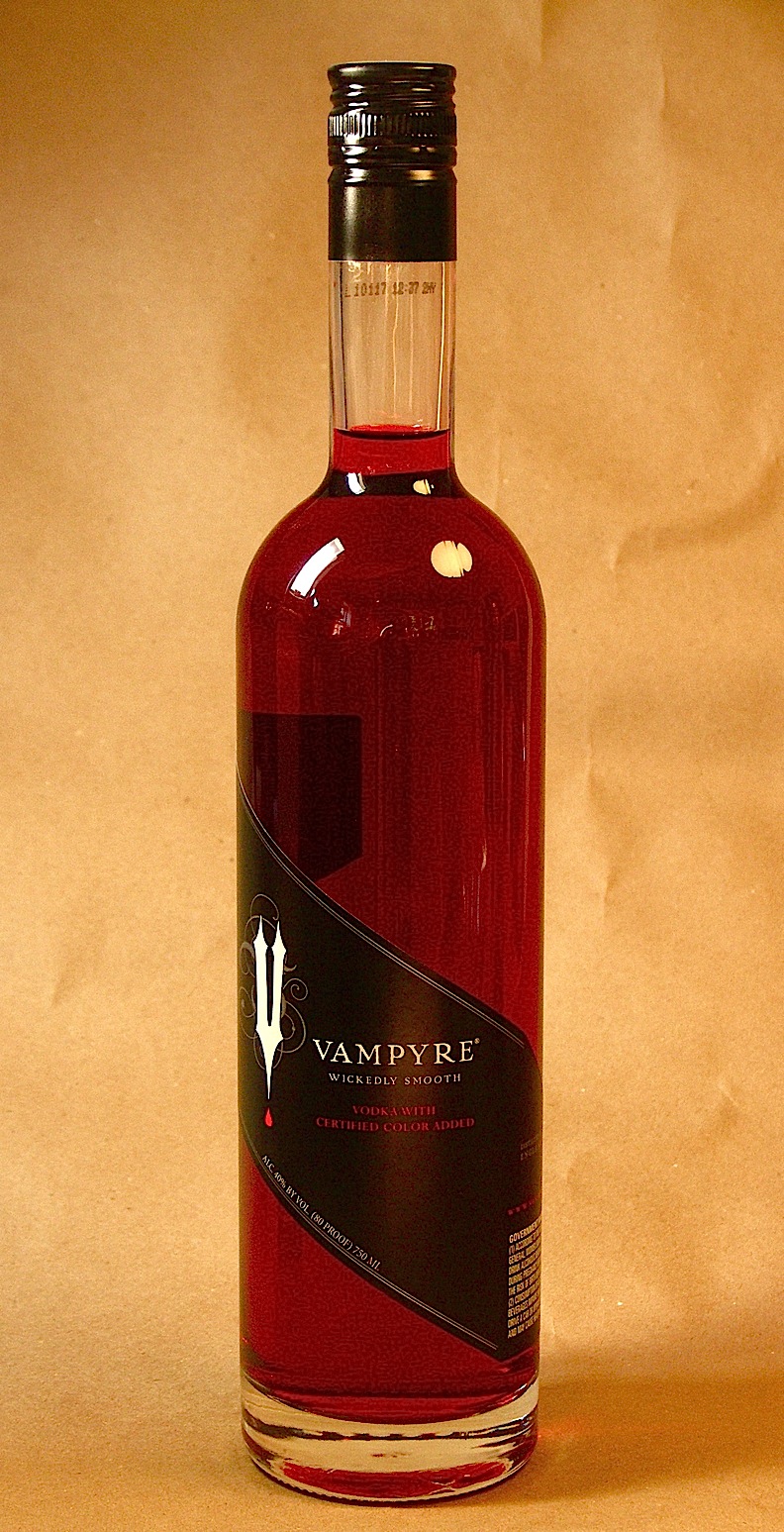 One
that
no
one
will ever mistake is the new Vampyre from England ($22),
which is “naturally
colored” a true, viscous blood red and whose ad say it was specially
created to
attract those creatures of the night. Whatever. It’s pretty bland with
little
aroma but velvety on the tongue. And fun
to drink.
One
that
no
one
will ever mistake is the new Vampyre from England ($22),
which is “naturally
colored” a true, viscous blood red and whose ad say it was specially
created to
attract those creatures of the night. Whatever. It’s pretty bland with
little
aroma but velvety on the tongue. And fun
to drink.
The
potato-based
Luksusowa
($14-$18)
has
a
strong
nose with real citrus in it and a
light burn on the tongue. A nice entry level example from Poland.
The
popular but expensive Chopin ($26-$30), also a potato-based Polish
vodka,
smells like little more than alcohol and has a faintly sweet flavor
with a mild
burn. Not at all distinctive.
Medea,
which
runs
$40
and
up,
is
from Holland, with a fairly bland nose and a sharp
burn to the sinuses. Not worth the money.
Sweden’s
Svedka
($14-$17)
has
built
a
following
among young drinkers, maybe because its
very smooth, but it’s almost flabby too, with an unpleasant
aroma.
I think my overall favorite was the grain-based I
Spirit ($35), from Italy, with a lovely aromatic nose, distinctly
flavorful with no intrusions from other ingredients, and a nice,
refined bite on the end of it. It's a collaboration between Arrigo
Cipriani. owner of Harry's Bar in Venice, Lapo Elkann of Fiat
Automobiles and Friulian distillers Marco Fantinel and Francesco
Cosulich, well known for their grappas.
Turning
to
U.S.-made
vodkas—and
there’s
a
slew
of them out there—I wasn’t
surprised
that good old Smirnoff ($14) pleased me so much with its bountiful
flavor,
though the aroma was slightly diesel-like. It’s a solid, good example
with
light burn.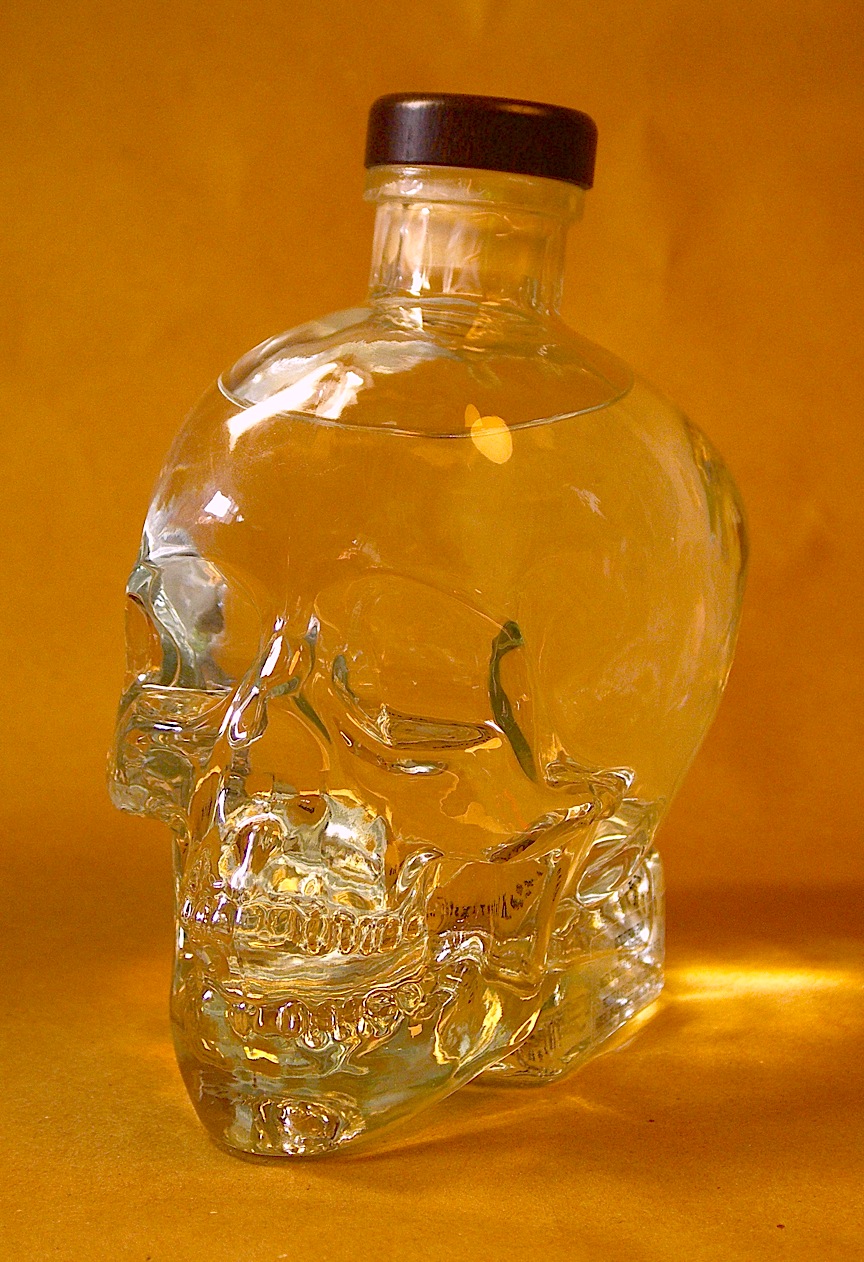
Smooth
Ambler
Whitewater
($30)
is
an
“artisanal”
grain vodka made in West Virginia,
that I could have sworn was apple-based calvados, from aroma to finish.
It has
some real taste to it and would probably stand out in a crowd of vodkas.
Star
($30),
made
in
“Oregon’s
scenic
Cascade
Mountains,” is a small batch vodka
made
from “handpicked” corn though I’d never mistake it for aged bourbon. It’s filtered
five times (most
premium vodkas go through thrice), which seems
to smooth it out but may rob it of its nose.
Bottles
of
Noon
Mountain
($20)
from
Indiana
are numbered and signed by master
distiller
Gerry Webb, who gives the product a lush, fruity aroma and spice, all
solidly
knit together.
 Tito’s
($22) from Texas has a very light nose, shows tangy on the palate, but
then
finishes hot as hell on the back of the throat. You’ll
know
it’s
from
Texas.
Tito’s
($22) from Texas has a very light nose, shows tangy on the palate, but
then
finishes hot as hell on the back of the throat. You’ll
know
it’s
from
Texas.
Crystal
Head
takes
its
name
from
the
admirably eerie skull-shaped bottle it comes
in,
together with two little skull jiggers. It’s based on the legend of the
magical
13 crystal skulls (the title for the last Indiana Jones movie), and the
founder
of the company is actor Dan Ackroyd. It has a pleasantly grassy
bouquet, is
very smooth, aromatic and not at all hot. And it comes from
Newfoundland. The
oddity has developed something of a cult following that will pay up to
$50 a
bottle.
And
last,
there’s
Ciroc
($29-$32),
made from French grapes, like brandy; in
fact,
one of the grapes used, ugni blanc, is also used to make cognac. It has
a very
citrusy nose and pretty tropical notes and a tangy, mild burn. I could
swear
there is a light flavoring in it, but it’s probably just the natural
grape
flavors. Sales have been very good, especially since Sean “Diddy” Combs
(left) became
a spokesman in 2007.
As I said, the
key to selling a tasteless, odorless, colorless spirit is a food ad
campaign.
John
Mariani's wine and spirits column appears in Bloomberg Muse News,
from
which
this
story
was
adapted.
Bloomberg
News
covers
Culture
from
art,
books,
and
theater
to
wine,
travel,
and
food
on
a
daily.
Follow @VirtualGourmet
❖❖❖
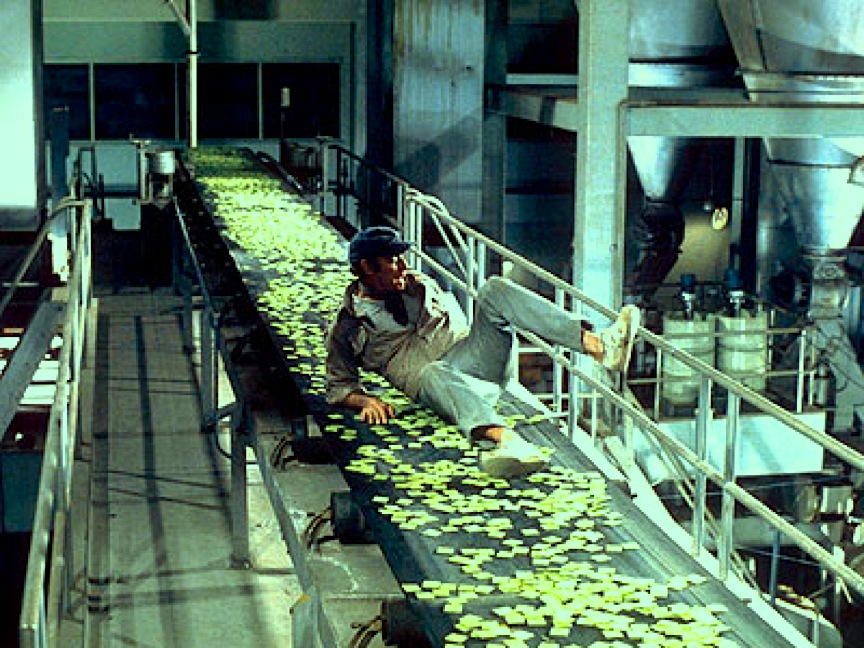 SOYLENT
GREEN IS. . . PEOPLE!!!!
SOYLENT
GREEN IS. . . PEOPLE!!!!
Researchers at the Beijing University of Chemical Technology have discovered a method for creating large quantities of human-derived gelatin, which in theory, could become a substitute for the thousands of tons of animal-based gelatin used in desserts, marshmallows, candies, and other products.
WHY
NOT
JUST
DRAG
A
TROUGH
INTO
THE
RESTAURANT AND LET THE SLOBS GO AT IT?
"Even as
recently as six or seven years ago, restaurants were still places where
you
made a reservation, sat down, ate an appetizer and then an
entrée, had coffee
with your dessert, and left. But now we're dining in a new era of
restaurant.
You know the kinds of places I'm talking about: No sign out front; the
bartender maybe has a carnation in his lapel; food is served on carving
boards
and granite slates; something vintage in the decor (taxidermy, rotary
phone,
estate sale cutlery); definitely no tablecloth in sight. Most of us
have
happily dispensed with the blazers and sauce spoons of the fine-dining
era and
are relieved to do away with archaic formalities like standing when a
lady
leaves the table."—Phoebe Damrosch, "Scruffy
Chic," Grub
Street, July 20.
Any of John Mariani's books below
may be ordered from amazon.com.
" A fact-filled,
entertaining history [that] substantiates its title with hundreds of
facts in this meaty history of the rise of Italian food culture around
the
globe. From Charles Dickens's journey through Italy in 1844 to
20th-century
immigrants to America selling ice cream on the streets of New Orleans,
Mariani
constantly surprises the reader with little-known culinary anecdotes
about
Italy and its people, who have made pasta and pizza household dishes in
the
U.S. and beyond."--Publishers Weekly "Equal
parts
history,
sociology,
gastronomy,
and
just
plain
fun,
How
Italian
Food
Conquered
the
World
tells
the
captivating
and
delicious
story
of
the
(let's
face
it)
everybody's
favorite
cuisine
with
clarity,
verve
and
more
than
one
surprise."--Colman
Andrews,
editorial
director
of
The
Daily Meal.com. "A
fantastic and fascinating read, covering everything from the influence
of Venice's spice trade to the impact of Italian immigrants in
America and the evolution of alta cucina. This book will serve as a
terrific resource to anyone interested in the real story of Italian
food."--Mary Ann Esposito, host of PBS-TV's Ciao Italia. "John
Mariani
has
written
the
definitive
history
of
how
Italians
won
their
way
into
our
hearts,
minds,
and
stomachs.
It's
a
story
of
pleasure
over
pomp
and
taste
over
technique."--Danny
Meyer,
owner
of
NYC
restaurants
Union
Square
Cafe,
Gotham
Bar
&
Grill,
The
Modern,
and
Maialino.
|
 |
 |
 |
 |
 |
 |
 |
 |
 Everett
Potter's
Travel
Report:
Everett
Potter's
Travel
Report: 
 Eating
Las
Vegas is the new on-line site for Virtual Gourmet
contributor John
A. Curtas., who since 1995 has been commenting on the Las Vegas food
scene and reviewing restaurants for Nevada Public Radio. He is
also
the restaurant critic for KLAS TV, Channel 8 in Las Vegas, and his past
reviews can be accessed at KNPR.org.
Click
on
the
logo
below
to
go
directly
to
his
site.
Eating
Las
Vegas is the new on-line site for Virtual Gourmet
contributor John
A. Curtas., who since 1995 has been commenting on the Las Vegas food
scene and reviewing restaurants for Nevada Public Radio. He is
also
the restaurant critic for KLAS TV, Channel 8 in Las Vegas, and his past
reviews can be accessed at KNPR.org.
Click
on
the
logo
below
to
go
directly
to
his
site.

Tennis Resorts Online: A Critical Guide to the World's Best Tennis Resorts and Tennis Camps, published by ROGER COX, who has spent more than two decades writing about tennis travel, including a 17-year stretch for Tennis magazine. He has also written for Arthur Frommer's Budget Travel, New York Magazine, Travel & Leisure, Esquire, Money, USTA Magazine, Men's Journal, and The Robb Report. He has authored two books-The World's Best Tennis Vacations (Stephen Greene Press/Viking Penguin, 1990) and The Best Places to Stay in the Rockies (Houghton Mifflin, 1992 & 1994), and the Melbourne (Australia) chapter to the Wall Street Journal Business Guide to Cities of the Pacific Rim (Fodor's Travel Guides, 1991).


The Family Travel Forum
- A community for those who
"Have Kids, Still Travel" and want to make family vacations more fun,
less work and better value. FTF's travel and parenting features,
including
reviews of tropical and ski resorts, reunion destinations, attractions,
holiday
weekends, family festivals, cruises, and all kinds of vacation ideas
should be
the first port of call for family vacation planners. http://www.familytravelforum.com/index.html
ALL YOU NEED BEFORE YOU GO


MARIANI'S VIRTUAL GOURMET NEWSLETTER is published weekly. Editor/Publisher: John Mariani.
Contributing Writers: Christopher
Mariani, Robert Mariani,
John A. Curtas, Edward Brivio, Mort
Hochstein, and
Brian Freedman. Contributing
Photographers: Galina Stepanoff-Dargery, Bobby Pirillo. Technical
Advisor:
Gerry McLoughlin.
You may unsubscribe from this newsletter by clicking
here.
© copyright John Mariani 2011
